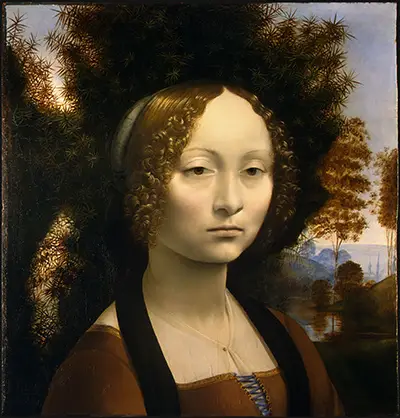Ginevra was around seventeen years old, well-educated and from a wealthy Florence family. It is likely that this portrait, possibly da Vinci's first, was made to commemorate Givenra de Benci's marriage to Luigi Niccolini that year.
Ginevra de Benci was said to have been beautiful. Da Vinci enhanced her beauty, painting her flawless, smooth skin.
He used the ends of his paintbrush to create her ringlets. Her elegant brown gown shows wonderful details of blue ribbon fastenings, gold braid and a gold pin. Ginevra de Benci is also wearing a black scarf which was fashionable a the time.
She is painted in front of a Juniper tree which is a slight pun, as "ginepro" the Italian word for juniper, suggests her name. In the distance, there are more trees and an expanse of water. Da Vinci creates a misty effect in the background using overlaid oil glazes to create his hazy sky.
This portrait was quite ground-breaking at the time as it show Ginevra de Benci in a three-quarter pose and her eyes gaze towards the viewer although not making direct contact. Da Vinci's contemporaries commented that this portrait was extremely lifelike.
Rather like the Mona Lisa, the viewer does not know what the unsmiling Ginevra de Benci was thinking, her expression is hard to read, perhaps she was thinking about the forthcoming marriage to a much older man. Da Vinci himself said that the best portraits showed a "state of mind".
The painting would have been slightly bigger originally, the bottom section has been lost and would have shown Ginevra de Benci's hands and arms. The reverse of the picture also has an interesting "emblematic painting" of a juniper sprig surrounded by a laurel and palm wreath with the Latin motto which translates to "Beauty Adorns Virtue".
The juniper represents Ginevra and is also a symbol of chastity. Art detectives have also discovered evidence of the personal emblem of the Venetian Ambassador to Florence, Bernado Bembo, is underneath and they suspect that he may have commissioned the emblematic painting on the rear. It is known that he and Ginevra de Benci were good friends.
Ginevra spent her later life in self imposed exile, trying to recover from illness and an ill fated love affair.
This wonderful portrait of Ginevra de Benci is one of Leonardo da Vinci's early masterpieces capturing the beautiful, young girl and her thoughts forever.


